Effect of Surface Modification for Efficient Electroplating of 3D-Printed Components
Abstract
1. Introduction
2. Materials and Methods
2.1. Experimental Setup
2.2. Electrodeposition
2.3. Measurement and Observation Methods
2.3.1. Height Parameters [28]
- Arithmetical mean height, Sa, is the average of the absolute values of the heights of peaks and valleys.
- Maximum height, Sz, is the sum of the maximum height of the peak and the maximum height of the valley.
- Maximum peak height, Sp, is the largest height value of peaks on a defined area of the surface.
- Maximum valley height, Sv, is the largest depth value of valleys on a defined area of surface.
2.3.2. Functional Parameters (Stratified Surfaces) [28]
- Core height, Sk, is the distance between the highest and lowest points of the core surface.
- Reduced peak height, Spk, is the height of the protruding peaks above the core surface after the reduction process.
3. Results and Discussion
3.1. Surface Topography
3.1.1. Height Parameters Sa, Sz, Sp, and Sv
3.1.2. Functional Parameters Sk and Spk
3.2. Coating Analysis by the Destructive Method
3.3. Recommendations for Further Research to Optimise This Technology
- The most significant improvement in surface quality was achieved through vapor smoothing, which reduces surface roughness and seals the porosity typical of powder-based printing technologies. This step helps to minimise height variations and irregularities.
- To bridge the non-conductive nature of the polymer, a conductive interlayer film based on graphite was applied to the surface. Spray application ensures uniform coverage without losing fine surface details.
- Electrochemical copper deposition was carried out using an acidic copper electrolyte. The process parameters, including current density and plating time, were optimised to produce a uniform copper layer with a thickness of 80–130 µm, without introducing defects such as cracking or delamination.
- Microscopic observation of the surface and cross-sections was used to assess the quality of the plating, allowing for the quantification of uniformity and integrity of the metal layer. In the future, it would be appropriate to include other evaluation methods, such as the grid adhesion test, surface analysis using SEM or CLSM, or micro/nanoindentation, which will enable the quantitative correlation of surface topographic parameters with copper coating properties.
4. Conclusions
Author Contributions
Funding
Data Availability Statement
Conflicts of Interest
References
- Xiao, S.; Li, J.; Wang, Z.; Chen, Y.; Tofighi, S. Advancing Additive Manufacturing Through Machine Learning Techniques: A State-of-the-Art Review. Future Internet 2024, 16, 419. [Google Scholar] [CrossRef]
- Zhou, L.; Miller, J.; Vezza, J.; Mayster, M.; Raffay, M.; Justice, Q.; Al Tamimi, Z.; Hansotte, G.; Sunkara, L.D.; Bernat, J. Additive Manufacturing: A Comprehensive Review. Sensors 2024, 24, 2668. [Google Scholar] [CrossRef] [PubMed]
- Marsalek, P.; Sotola, M.; Rybansky, D.; Repa, V.; Halama, R.; Fusek, M.; Prokop, J. Modeling and testing of flexible structures with selected planar patterns used in biomedical applications. Materials 2021, 14, 140. [Google Scholar] [CrossRef] [PubMed]
- Prathyusha, A.L.R.; Raghu Babu, G. A review on additive manufacturing and topology optimization process for weight reduction studies in various industrial applications. Mater. Today Proc. 2022, 62, 109–117. [Google Scholar] [CrossRef]
- Mesicek, J.; Jancar, L.; Ma, Q.-P.; Hajnys, J.; Tanski, T.; Krpec, P.; Pagac, M. Comprehensive view of topological optimization scooter frame design and manufacturing. Symmetry 2021, 13, 1201. [Google Scholar] [CrossRef]
- Kozior, T. The Influence of Selected Selective Laser Sintering Technology Process Parameters on Stress Relaxation, Mass of Models, and Their Surface Texture Quality. 3D Print. Addit. Manuf. 2020, 7, 126–138. [Google Scholar] [CrossRef] [PubMed]
- Zmarzły, P.; Kozior, T.; Gogolewski, D. The effect of non-measured points on the accuracy of the surface topography assessment of elements 3D printed using selected additive technologies. Materials 2023, 16, 460. [Google Scholar] [CrossRef] [PubMed]
- Zarybnicka, L.; Petrů, J.; Krpec, P.; Pagáč, M. Effect of additives and print orientation on the properties of laser sintering-printed polyamide 12 components. Polymers 2022, 14, 1172. [Google Scholar] [CrossRef] [PubMed]
- Mesicek, J.; Vacek, M.; Ma, Q.-P.; Krejsa, M.; Hajnys, J.; Krivy, V.; Pagac, M.; Petru, J. Exploring the Impact of Saline Environments on the Properties of EOS PA2200: A Study on Weight Gain and Mechanical Characteristics. MM Sci. J. 2024, 10, 7534–7538. [Google Scholar] [CrossRef]
- Baligidad, S.M.; Kumar, G.C.; Maharudresh, A.C.; Elangovan, K. Experimental investigations on metallization in laser-sintered PA12 part using RF sputtering. Appl. Phys. A 2021, 127, 510. [Google Scholar] [CrossRef]
- Brown, S.C.; Robert, C.; Koutsos, V.; Ray, D. Methods of modifying through-thickness electrical conductivity of CFRP for use in structural health monitoring, and its effect on mechanical properties—A review. Compos. Part A Appl. Sci. Manuf. 2020, 133, 105885. [Google Scholar] [CrossRef]
- Afshar, A.; Liao, H.-T.; Chiang, F.; Korach, C.S. Time-dependent changes in mechanical properties of carbon fiber vinyl ester composites exposed to marine environments. Compos. Struct. 2016, 144, 80–85. [Google Scholar] [CrossRef]
- Macit, Ş.; Uraz, C. Electroless Cu plating on ABS plastic by using environmentally friendly chemicals. Deu Muhendis. Fak. Fen Ve Muhendis. 2018, 20, 369–375. [Google Scholar]
- Hüner, B.; Demir, N.; Kaya, M.F. Electrodeposition of NiCu bimetal on 3D printed electrodes for hydrogen evolution reactions in alkaline media. Int. J. Hydrogen Energy 2022, 47, 12136–12146. [Google Scholar] [CrossRef]
- Hopmann, C.; Fragner, J.; Haase, S. Development of electrically conductive plastic compounds based on filler combinations. J. Plast. Technol. 2014, 2, 49–67. [Google Scholar]
- Kim, M.J.; Cruz, M.A.; Ye, S.; Gray, A.L.; Smith, G.L.; Lazarus, N.; Walker, C.J.; Sigmarsson, H.H.; Wiley, B.J. One-step electrodeposition of copper on conductive 3D printed objects. Addit. Manuf. 2019, 27, 318–326. [Google Scholar] [CrossRef]
- Pollitt, J.N.; Christofidis, G.; Morrissey, J.; Birkett, J.W. Vacuum metal deposition enhancement of friction ridge detail on ballistic materials. Forensic Sci. Int. 2020, 316, 110551. [Google Scholar] [CrossRef] [PubMed]
- Juarez, T.; Schroer, A.; Schwaiger, R.; Hodge, A.M. Evaluating sputter deposited metal coatings on 3D printed polymer micro-truss structures. Mater. Des. 2018, 140, 442–450. [Google Scholar] [CrossRef]
- Islam, A.; Hansen, H.N.; Tang, P.T. Direct electroplating of plastic for advanced electrical applications. CIRP Ann. 2017, 66, 209–212. [Google Scholar] [CrossRef]
- Krupova, H.; Sternadelova, K.; Mesicek, J.; Ma, Q.-P.; Hajnys, J. Experimental evaluation of selectively laser sintered polyamide 12 surface treatment for direct electrodeposition. Prog. Org. Coat. 2024, 186, 107968. [Google Scholar] [CrossRef]
- Marciniak, D. Assessment of the surface and structure of elements produced in additive manufacturing technology after chemical treatment. MATEC Web Conf. 2021, 332, 01010. [Google Scholar] [CrossRef]
- Marciniak, D.; Szewczykowski, P.; Bielinski, M. Effect of surface modification by acetone vaporization on the structure of 3D printed acrylonitrile-butadiene-styrene elements. Polimery 2018, 63, 785–790. [Google Scholar] [CrossRef]
- Giurlani, W.; Berretti, E.; Innocenti, M.; Lavacchi, A. Measuring the Thickness of Metal Coatings: A Review of the Methods. Coatings 2020, 10, 1211. [Google Scholar] [CrossRef]
- Melentiev, R.; Yudhanto, A.; Tao, R.; Vuchkov, T.; Lubineau, G. Metallization of polymers and composites: State-of-the-art approaches. Mater. Des. 2022, 221, 110958. [Google Scholar] [CrossRef]
- Schroer, D.; Nichols, R.J.; Meyer, H. Pretreatment of polymer surfaces—The crucial step prior to metal deposition. Electrochim. Acta 1995, 40, 1487–1494. [Google Scholar] [CrossRef]
- Tischer, F.; Cholewa, S.; Düsenberg, B.; Drummer, D.; Bück, A.; Peukert, W.; Schmidt, J. Closed Loop Recycling Approach for Aged Polyamide 12 Feedstocks for Powder Bed Fusion by Precipitation from a Moderate Solvent Combined with Solvolysis. Addit. Manuf. 2025, 107, 104822. [Google Scholar] [CrossRef]
- Martynková, G.S.; Slíva, A.; Kratošová, G.; Barabaszová, K.Č.; Študentová, S.; Klusák, J.; Brožová, S.; Dokoupil, T.; Holešová, S. Polyamide 12 materials study of morpho-structural changes during laser sintering of 3D printing. Polymers 2021, 13, 810. [Google Scholar] [CrossRef] [PubMed]
- ISO 25178-2; Geometrical Product Specifications (GPS)—Surface Texture: Areal—Part 2: Terms, Definitions and Surface Texture Parameters. International Organization for Standardization: Geneva, Switzerland, 2021.
- Nagalingam, A.P.; Vohra, M.S.; Kapur, P.; Yeo, S.H. Effect of Cut-Off, Evaluation Length, and Measurement Area in Profile and Areal Surface Texture Characterization of As-Built Metal Additive Manufactured Components. Appl. Sci. 2021, 11, 5089. [Google Scholar] [CrossRef]
- Zhang, T.; Yuan, L. Understanding surface roughness on vertical surfaces of 316 L stainless steel in laser powder bed fusion additive manufacturing. Powder Technol. 2022, 411, 117957. [Google Scholar] [CrossRef]
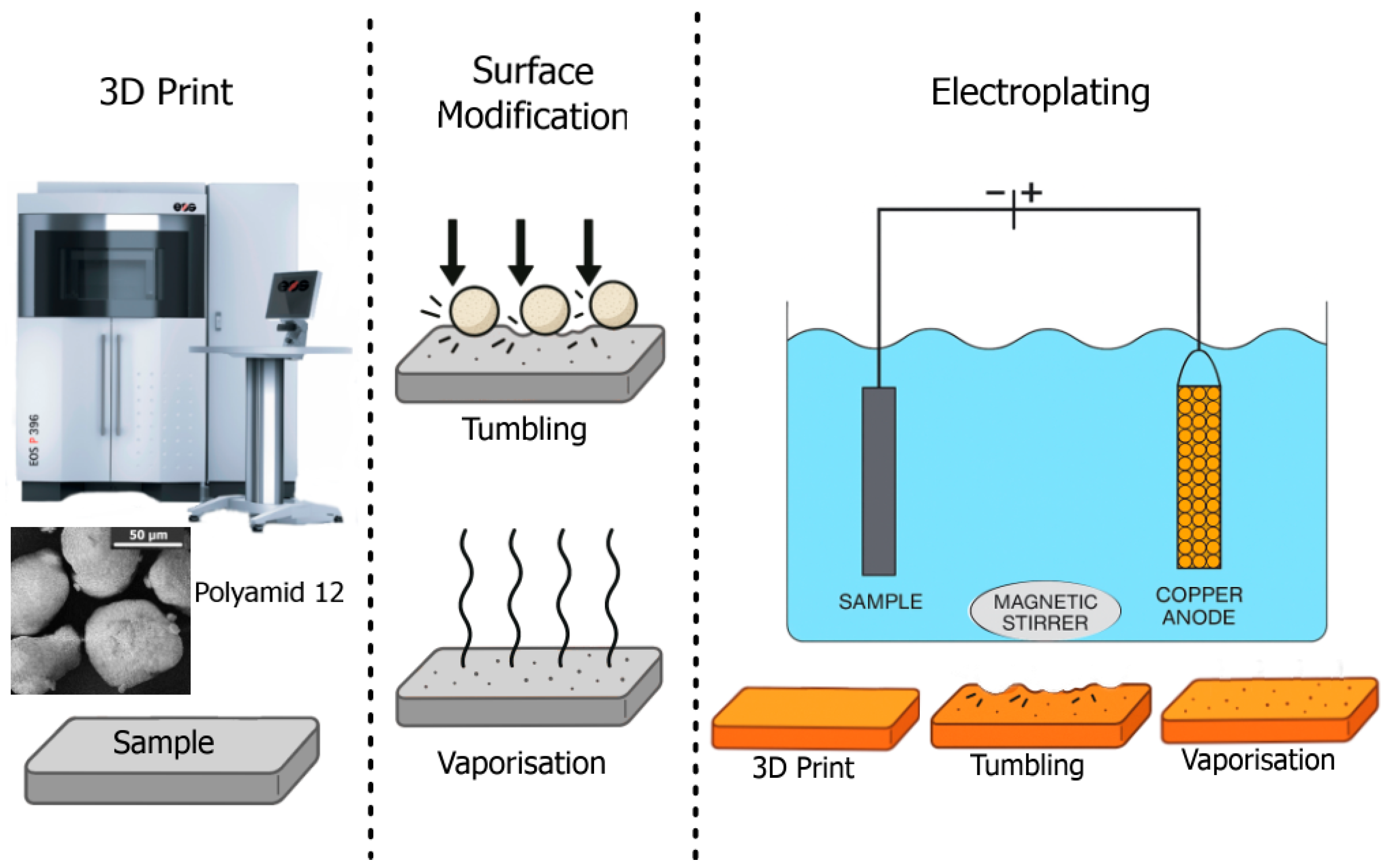
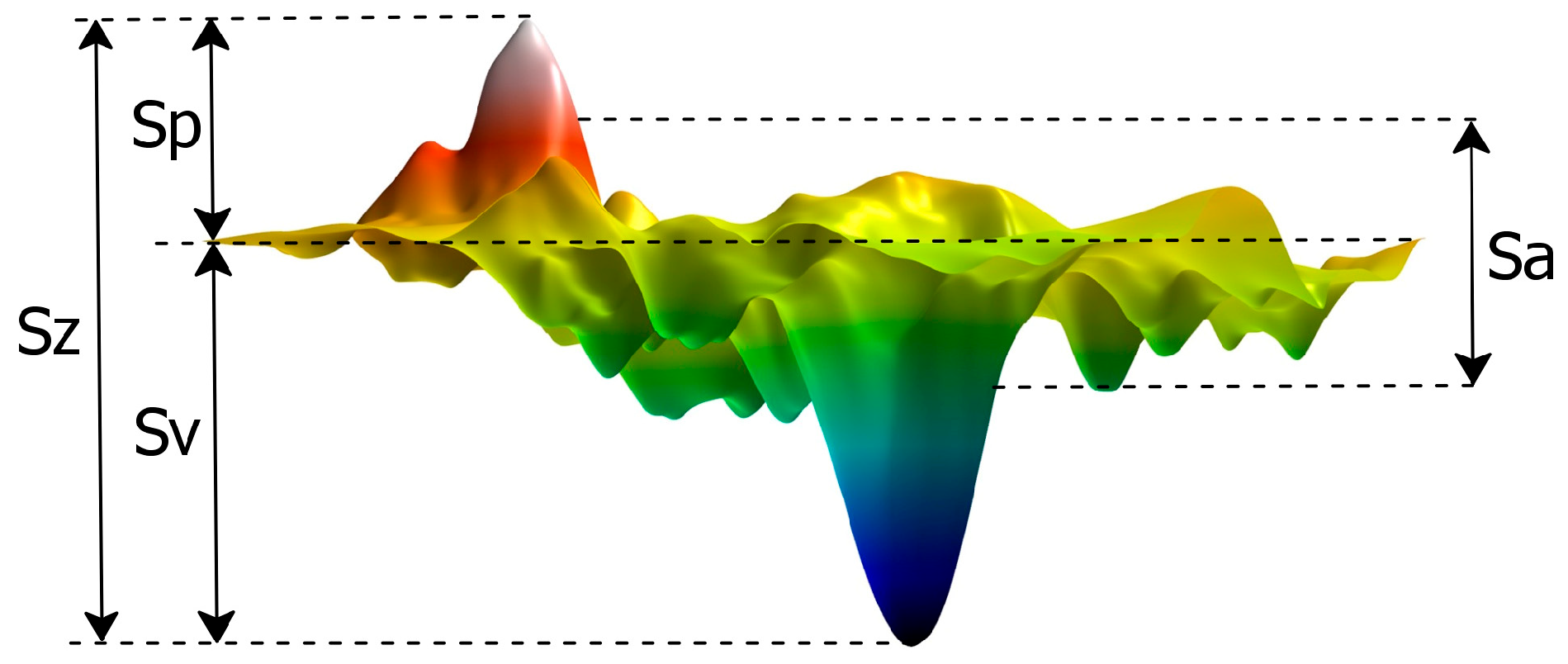
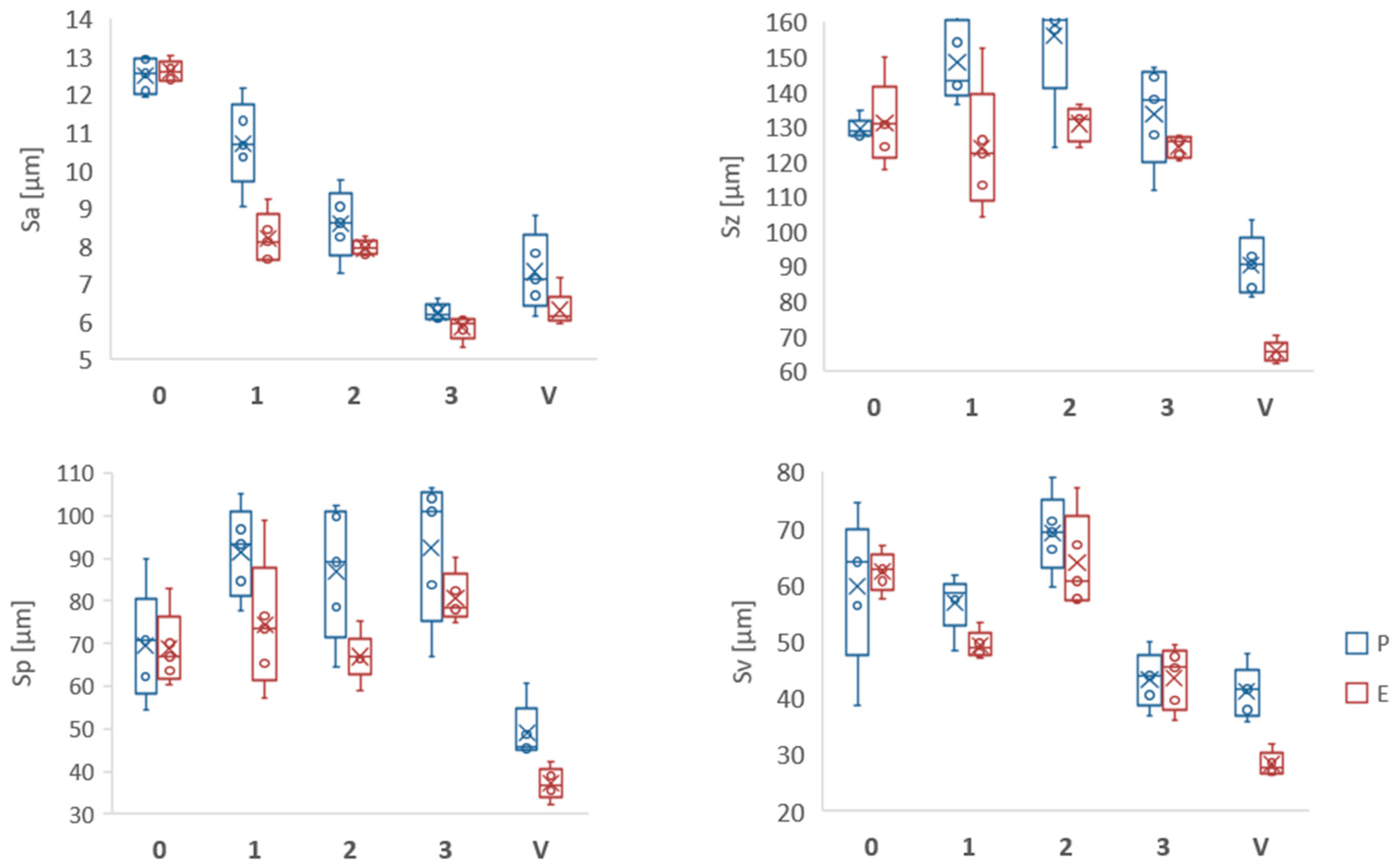
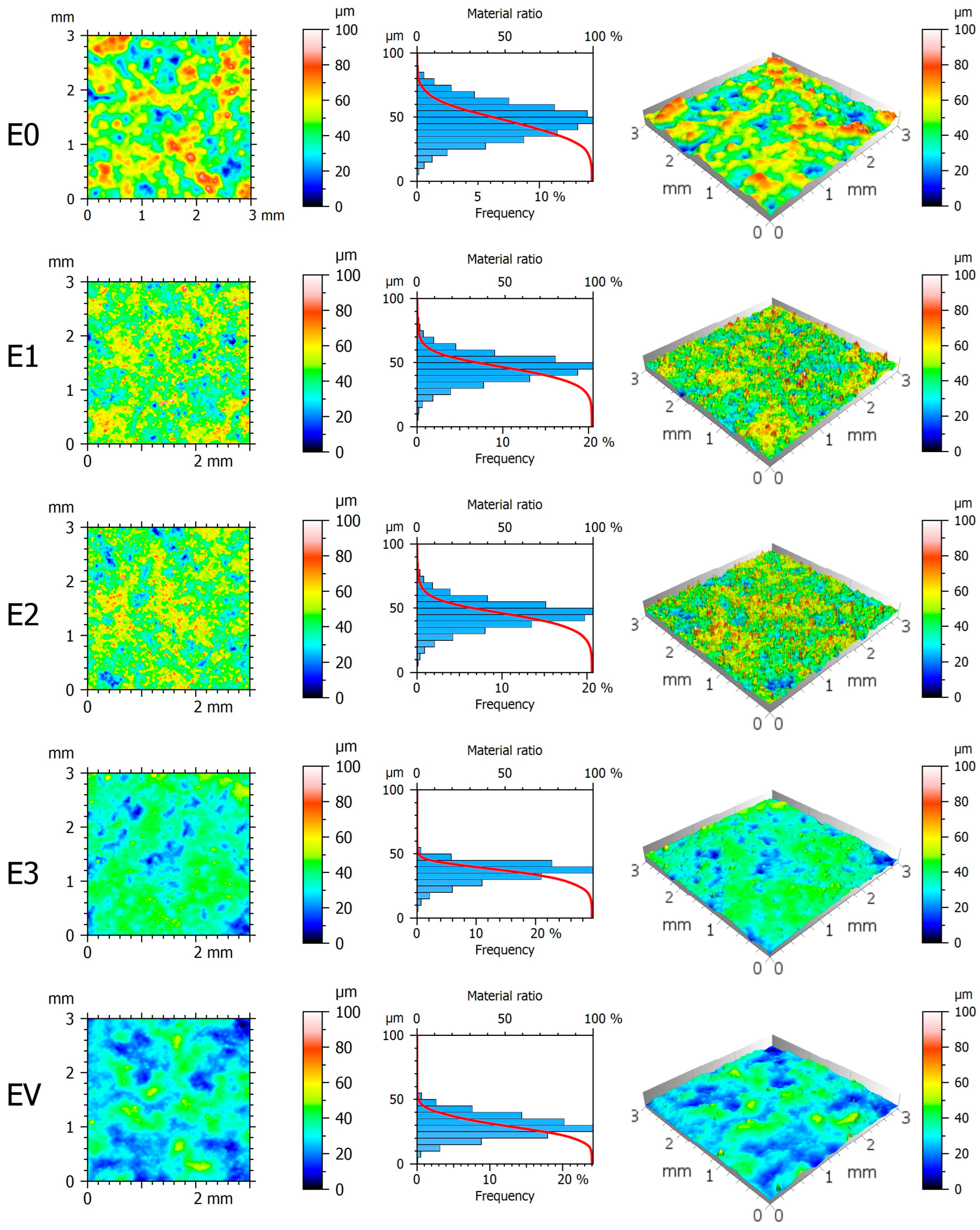
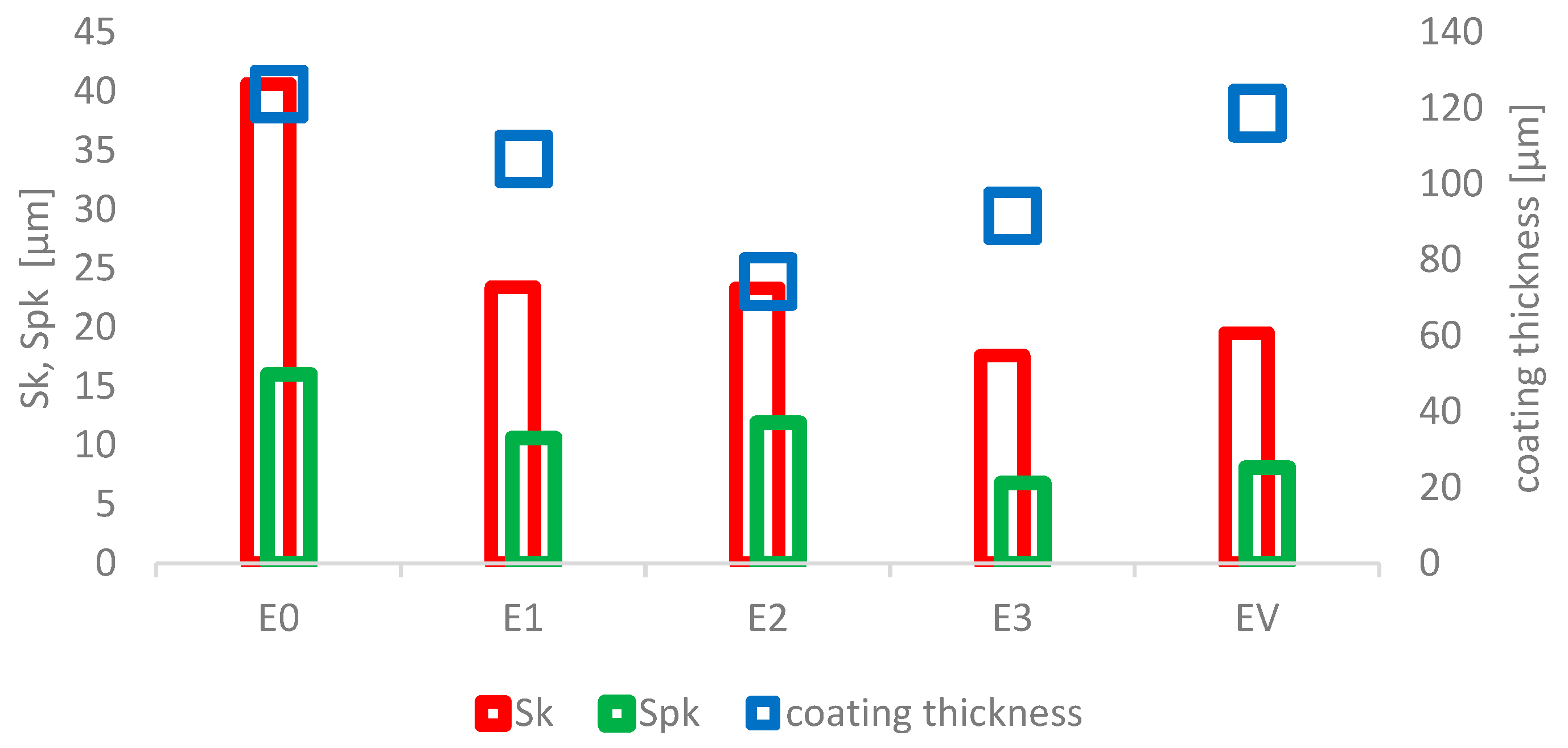

| Sa [µm] | Sz [µm] | Sp [µm] | Sv [µm] | Sk [µm] | Spk [µm] | ||
|---|---|---|---|---|---|---|---|
| P0 | 12.5 ± 0.4 | 129.4 ± 2.7 | 69.6 ± 11.8 | 59.8 ± 12.0 | 39.6 ± 1.4 | 19.8 ± 1.2 | |
| P1 | 10.7 ± 1.0 | 148.5 ± 10.9 | 91.5 ± 9.6 | 56.9 ± 4.5 | 31.0 ± 1.4 | 19.1 ± 2.2 | |
| P2 | 8.6 ± 0.8 | 155.9 ± 16.5 | 86.9 ± 14.0 | 69.1 ± 6.3 | 16.8 ± 1.1 | 19.5 ± 2.3 | |
| P3 | 6.2 ± 0.2 | 133.6 ± 12.8 | 92.4 ± 15.1 | 43.2 ± 4.4 | 16.3 ± 1.2 | 13.8 ± 1.8 | |
| PV | 7.3 ± 0.9 | 90.3 ± 7.7 | 49.2 ± 6.0 | 41.1 ± 4.1 | 32.6 ± 1.3 | 12.8 ± 1.3 | |
| Electroplating | E0 | 12.6 ± 0.2 | 131.0 ± 10.7 | 68.7 ± 7.8 | 62.3 ± 3.1 | 40.6 ± 1.4 | 16.0 ± 1.2 |
| E1 | 8.2 ± 0.6 | 123.6 ± 16.2 | 74.3 ± 14.1 | 49.4 ± 2.1 | 23.4 ± 0.9 | 10.6 ± 1.0 | |
| E2 | 7.9 ± 0.2 | 130.8 ± 4.5 | 66.9 ± 5.2 | 63.9 ± 7.6 | 23.3 ± 0.5 | 11.9 ± 0.6 | |
| E3 | 5.8 ± 0.3 | 124.3 ± 2.8 | 80.7 ± 5.3 | 43.6 ± 5.0 | 17.6 ± 0.9 | 6.8 ± 0.4 | |
| EV | 6.3 ± 0.4 | 65.6 ± 2.7 | 37.2 ± 3.4 | 28.3 ± 2.0 | 19.5 ± 0.3 | 8.1 ± 0.6 |
| Sample | E0 | E1 | E2 | E3 | EV |
|---|---|---|---|---|---|
| Value | 123.7 ± 6.7 µm | 106.6 ± 7.9 µm | 74.3 ± 6.4 µm | 91.6 ± 7.7 µm | 118.7 ± 7.3 µm |
Disclaimer/Publisher’s Note: The statements, opinions and data contained in all publications are solely those of the individual author(s) and contributor(s) and not of MDPI and/or the editor(s). MDPI and/or the editor(s) disclaim responsibility for any injury to people or property resulting from any ideas, methods, instructions or products referred to in the content. |
© 2025 by the authors. Licensee MDPI, Basel, Switzerland. This article is an open access article distributed under the terms and conditions of the Creative Commons Attribution (CC BY) license (https://creativecommons.org/licenses/by/4.0/).
Share and Cite
Klichová, D.; Krupová, H.; Měsíček, J.; Botko, F.; Radchenko, S. Effect of Surface Modification for Efficient Electroplating of 3D-Printed Components. Machines 2025, 13, 630. https://doi.org/10.3390/machines13070630
Klichová D, Krupová H, Měsíček J, Botko F, Radchenko S. Effect of Surface Modification for Efficient Electroplating of 3D-Printed Components. Machines. 2025; 13(7):630. https://doi.org/10.3390/machines13070630
Chicago/Turabian StyleKlichová, Dagmar, Hana Krupová, Jakub Měsíček, František Botko, and Světlana Radchenko. 2025. "Effect of Surface Modification for Efficient Electroplating of 3D-Printed Components" Machines 13, no. 7: 630. https://doi.org/10.3390/machines13070630
APA StyleKlichová, D., Krupová, H., Měsíček, J., Botko, F., & Radchenko, S. (2025). Effect of Surface Modification for Efficient Electroplating of 3D-Printed Components. Machines, 13(7), 630. https://doi.org/10.3390/machines13070630







